
Vitreous enamel, also called porcelain enamel, is a material made by fusing powdered glass to a substrate by firing, usually between 750 and 850 °C. The powder melts, flows, and then hardens to a smooth, durable vitreous coating. The word vitreous comes from the Latin vitreus, meaning "glassy".

The St Cuthbert Gospel, also known as the Stonyhurst Gospel or the St Cuthbert Gospel of St John, is an early 8th-century pocket gospel book, written in Latin. Its finely decorated leather binding is the earliest known Western bookbinding to survive, and both the 94 vellum folios and the binding are in outstanding condition for a book of this age. With a page size of only 138 by 92 millimetres, the St Cuthbert Gospel is one of the smallest surviving Anglo-Saxon manuscripts. The essentially undecorated text is the Gospel of John in Latin, written in a script that has been regarded as a model of elegant simplicity.

The Codex Aureus of St. Emmeram is a 9th-century illuminated Gospel Book. It takes its name from Saint Emmeram's Abbey, where it was for most of its history and is lavishly illuminated. The cover of the codex is decorated with gems and relief figures in gold, and can be precisely dated to 870, and is an important example of Carolingian art, as well as one of very few surviving treasure bindings of this date.

Cloisonné is an ancient technique for decorating metalwork objects with colored material held in place or separated by metal strips or wire, normally of gold. In recent centuries, vitreous enamel has been used, but inlays of cut gemstones, glass and other materials were also used during older periods; indeed cloisonné enamel very probably began as an easier imitation of cloisonné work using gems. The resulting objects can also be called cloisonné. The decoration is formed by first adding compartments to the metal object by soldering or affixing silver or gold as wires or thin strips placed on their edges. These remain visible in the finished piece, separating the different compartments of the enamel or inlays, which are often of several colors. Cloisonné enamel objects are worked on with enamel powder made into a paste, which then needs to be fired in a kiln. If gemstones or colored glass are used, the pieces need to be cut or ground into the shape of each cloison.
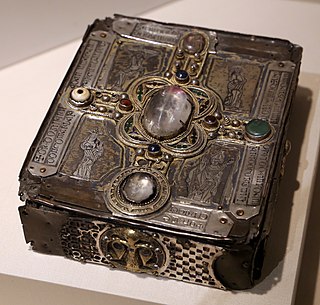
A cumdach or book shrine is an elaborate ornamented metal reliquary box or case used to hold Early Medieval Irish manuscripts or relics. They are typically later than the book they contain, often by several centuries. In most surviving examples the book comes from the peak age of Irish monasticism before 800, and the extant cumdachs date from after 1000, although it is clear the form dates from considerably earlier. The majority are of Irish origin, with most surviving examples held by the National Museum of Ireland (NMI).
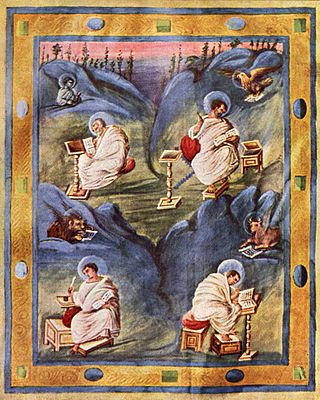
Carolingian art comes from the Frankish Empire in the period of roughly 120 years from about 780 to 900—during the reign of Charlemagne and his immediate heirs—popularly known as the Carolingian Renaissance. The art was produced by and for the court circle and a group of important monasteries under Imperial patronage; survivals from outside this charmed circle show a considerable drop in quality of workmanship and sophistication of design. The art was produced in several centres in what are now France, Germany, Austria, northern Italy and the Low Countries, and received considerable influence, via continental mission centres, from the Insular art of the British Isles, as well as a number of Byzantine artists who appear to have been resident in Carolingian centres.

Ottonian art is a style in pre-romanesque German art, covering also some works from the Low Countries, northern Italy and eastern France. It was named by the art historian Hubert Janitschek after the Ottonian dynasty which ruled Germany and Northern Italy between 919 and 1024 under the kings Henry I, Otto I, Otto II, Otto III and Henry II. With Ottonian architecture, it is a key component of the Ottonian Renaissance. However, the style neither began nor ended to neatly coincide with the rule of the dynasty. It emerged some decades into their rule and persisted past the Ottonian emperors into the reigns of the early Salian dynasty, which lacks an artistic "style label" of its own. In the traditional scheme of art history, Ottonian art follows Carolingian art and precedes Romanesque art, though the transitions at both ends of the period are gradual rather than sudden. Like the former and unlike the latter, it was very largely a style restricted to a few of the small cities of the period, and important monasteries, as well as the court circles of the emperor and his leading vassals.

A book cover is any protective covering used to bind together the pages of a book. Beyond the familiar distinction between hardcovers and paperbacks, there are further alternatives and additions, such as dust jackets, ring-binding, and older forms such as the nineteenth-century "paper-boards" and the traditional types of hand-binding. The term "Bookcover" is often used for a book cover image in library management software. This article is concerned with modern mechanically produced covers.
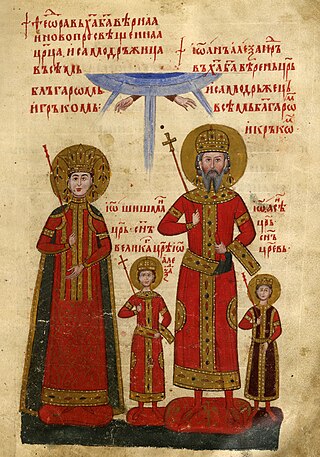
The Gospels of Tsar Ivan Alexander, Tetraevangelia of Ivan Alexander, or Four Gospels of Ivan Alexander is an illuminated manuscript Gospel Book, written and illustrated in 1355–1356 for Tsar Ivan Alexander of the Second Bulgarian Empire. The manuscript is regarded as one of the most important manuscripts of medieval Bulgarian culture, and has been described as "the most celebrated work of art produced in Bulgaria before it fell to the Turks in 1393".

A bookmark is a thin marking tool, commonly made of card, leather, or fabric, used to keep track of a reader's progress in a book and allow the reader to easily return to where the previous reading session ended. Alternate materials for bookmarks are paper, metals like silver and brass, silk, wood, cord (sewing), and plastic. Some books may have one or more bookmarks made of woven ribbon sewn into the binding. Furthermore, other bookmarks incorporate a page-flap that enables them to be clipped on a page.

Bindery refers to a studio, workshop or factory where sheets of (usually) paper are fastened together to make books, but also where gold and other decorative elements are added to the exterior of books, where boxes or slipcases for books are made and where the restoration of books is carried out.
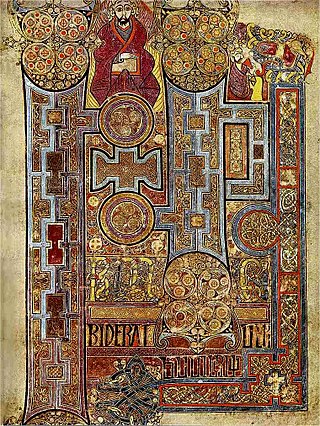
Insular art, also known as Hiberno-Saxon art, was produced in the post-Roman era of Great Britain and Ireland. The term derives from insula, the Latin term for "island"; in this period Britain and Ireland shared a largely common style different from that of the rest of Europe. Art historians usually group Insular art as part of the Migration Period art movement as well as Early Medieval Western art, and it is the combination of these two traditions that gives the style its special character.

Coptic binding or Coptic sewing comprises methods of bookbinding employed by early Christians in Egypt, the Copts, and used from as early as the 2nd century AD to the 11th century. The term is also used to describe modern bindings sewn in the same style.

Bookbinding is the process of building a book, usually in codex format, from an ordered stack of paper sheets with one's hands and tools, or in modern publishing, by a series of automated processes. Firstly, one binds the sheets of papers along an edge with a thick needle and strong thread. One can also use loose-leaf rings, binding posts, twin-loop spine coils, plastic spiral coils, and plastic spine combs, but they last for a shorter time. Next, one encloses the bound stack of paper in a cover. Finally, one places an attractive cover onto the boards, and features the publisher's information and artistic decorations.
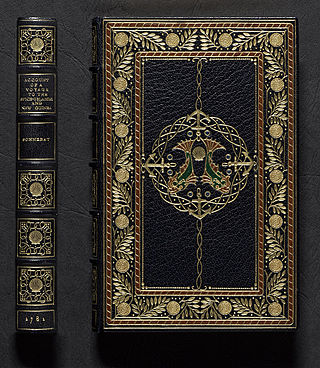
Sangorski & Sutcliffe is a firm of bookbinders established in London in 1901. It is considered to be one of the most important bookbinding companies of the 20th century, famous for its luxurious jeweled bindings that used real gold and precious stones in their book covers.

Hardstone carving, in art history and archaeology, is the artistic carving of semi-precious stones, such as jade, rock crystal, agate, onyx, jasper, serpentinite, or carnelian, and for objects made in this way. Normally the objects are small, and the category overlaps with both jewellery and sculpture. Hardstone carving is sometimes referred to by the Italian term pietre dure; however, pietra dura is the common term used for stone inlay work, which causes some confusion.

The British Library contains a wide range of fine and historic bookbindings; however, books in the Library are organised primarily by subject rather than by binding so the Library has produced a guide to enable researchers to identity bindings of interest. The collection includes the oldest intact Western bookbinding, the leather binding of the 7th century St Cuthbert Gospel.

The Lindau Gospels is an illuminated manuscript in the Morgan Library in New York, which is important for its illuminated text, but still more so for its treasure binding, or metalwork covers, which are of different periods. The oldest element of the book is what is now the back cover, which was probably produced in the later 8th century in modern Austria, but in the context of missionary settlements from Britain or Ireland, as the style is that of the Insular art of the British Isles. The upper cover is late Carolingian work of about 880, and the text of the gospel book itself was written and decorated at the Abbey of Saint Gall around the same time, or slightly later.

The Middle Ages was a period that spanned approximately 1000 years and is normally restricted to Europe and the Byzantine Empire. The material remains we have from that time, including jewelry, can vary greatly depending on the place and time of their creation, especially as Christianity discouraged the burial of jewellery as grave goods, except for royalty and important clerics, who were often buried in their best clothes and wearing jewels. The main material used for jewellery design in antiquity and leading into the Middle Ages was gold. Many different techniques were used to create working surfaces and add decoration to those surfaces to produce the jewellery, including soldering, plating and gilding, repoussé, chasing, inlay, enamelling, filigree and granulation, stamping, striking and casting. Major stylistic phases include barbarian, Byzantine, Carolingian and Ottonian, Viking, and the Late Middle Ages, when Western European styles became relatively similar.

Embroidered binding, also referred to as needlework or textile binding, describes a book bound in cloth and decorated with a design on one or both covers and sometimes the spine. The binding is created for the individual book.



































